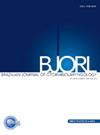Application of an active middle ear implant in congenital middle ear malformations: A contemporary review
IF 1.7
4区 医学
Q2 OTORHINOLARYNGOLOGY
引用次数: 0
Abstract
Objective
To evaluate hearing outcomes and postoperative complications among patients with middle and external ear malformations undergoing active middle ear implantation with Vibrant Soundbridge® (VSB).
Methods
Review of the literature. Studies published in English, Portuguese, or Spanish at the following databases: PubMed, MEDLINE, Scopus, Web of Science, EMBASE, and Cochrane Library were searched. The search strategy yielded a total of 141 potentially relevant studies. Of these, ten were included in this analysis.
Results
The mean preoperative air conduction threshold was 66.7 ± 6.2 dB. The mean air-bone gap was 46 ± 7.7 dB. VSB implantation resulted in mean hearing gain of 40.5 ± 7.1 dB in the air-conduction thresholds among the evaluated frequencies. The speech recognition index if the Floating Mass Transducer (FMT) was placed in the short process was 86.0% ± 9.6%, with significant difference when compared to long process coupling (p = 0.035) and the round window coupling (p = 0.048).
Conclusion
Bone conduction thresholds did not worsen in any of the studies included in the present review. VSB implantation resulted in a mean hearing gain of 40 dB at air conduction thresholds.
求助全文
约1分钟内获得全文
求助全文
来源期刊

Brazilian Journal of Otorhinolaryngology
OTORHINOLARYNGOLOGY-
CiteScore
3.00
自引率
0.00%
发文量
205
审稿时长
4-8 weeks
期刊介绍:
Brazilian Journal of Otorhinolaryngology publishes original contributions in otolaryngology and the associated areas (cranio-maxillo-facial surgery and phoniatrics). The aim of this journal is the national and international divulgation of the scientific production interesting to the otolaryngology, as well as the discussion, in editorials, of subjects of scientific, academic and professional relevance.
The Brazilian Journal of Otorhinolaryngology is born from the Revista Brasileira de Otorrinolaringologia, of which it is the English version, created and indexed by MEDLINE in 2005. It is the official scientific publication of the Brazilian Association of Otolaryngology and Cervicofacial Surgery. Its abbreviated title is Braz J Otorhinolaryngol., which should be used in bibliographies, footnotes and bibliographical references and strips.
 求助内容:
求助内容: 应助结果提醒方式:
应助结果提醒方式:


